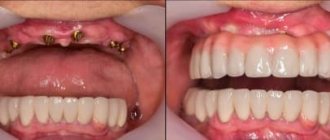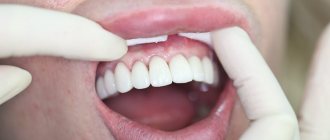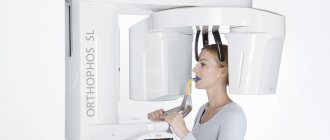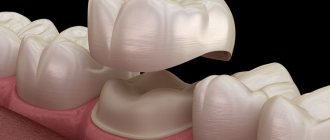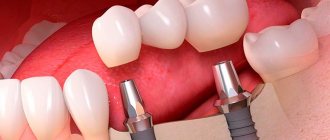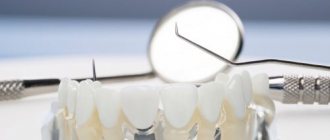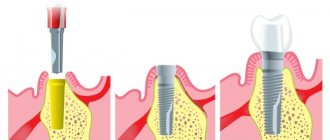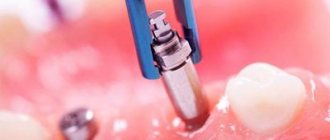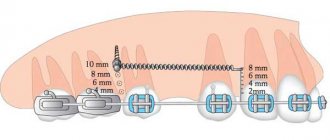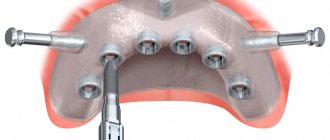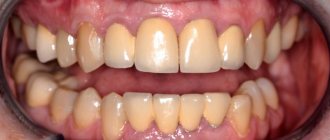Patients who have an idea about traditional implantation often wonder what basal implantation is and what is its feature. Basal implantation is considered a type of technology for the use of implants, which is practiced when patients have a lack of bone tissue. In this case, the emphasis shifts to the deep (basal) bone layers, which are not subject to atrophic processes.
To understand the peculiarities of using basal implantation, which is called single-phase, let’s first try to consider in a simplified form the issue of the anatomical structure of the bone tissue of the jaws. The roots of the teeth are fixed in the bone tissue, but if a person loses them, then the bones are at risk of deformation and atrophy due to weakening or complete lack of load. The fact is that the entire chewing process activates the metabolism in bone tissue, and in the absence of teeth, their activity stops, and the bone, deprived of the load, becomes deformed and noticeably decreases in volume.
Spongy layer
- a relatively porous and more susceptible to atrophy section of bone tissue, where implants are usually implanted using the traditional technique;
Cortical layer
- more dense, consisting of mineral salts;
Basal layer
- the most deeply located, containing many strong partitions and practically not deformed in the absence of teeth.
Taking into account the strength of the structure of the basal layer, root-shaped basal implants are fixed in it, opening up the prospect of restoring new teeth without building up bone tissue. In addition, unlike traditional implantation, basal dental implantation does not require a long waiting period for prosthetics. Accelerated basal implantation technique, often called “single-stage implantation”
, allows you to start prosthetics 3-5 days after the end of the implant procedure. With the traditional form of implantation, the distance from implantation to prosthetics reaches 3-6 months.
What is basal implantation?
Let's try to give an analogy to make it clear what basal implantation is. If you place a stick in the ground using only the top loose layer, it will not hold well. But if you use deeper layers that are not washed out by water or exposed to other external influences, the stick can be secured much more firmly and will last longer. The same goes for basal dental implantation.
Basal complex is a type of implantation in one stage with immediate loading. The main difference between the basal implantation method and other protocols is that the installation of implants does not require the presence of alveolar cancellous bone, the most central part of the jaw bone tissue. It is used to install most classical implants. Basal implants work with fundamentally different sections: the cortical plate, basal bone, buttresses of the skull, nasal, zygomatic and sphenoid bone. To ensure that the bone and implant have a large contact surface, artificial roots are installed at a certain angle. Angling also helps to select the most suitable areas of bone and place implants bypassing the sinuses and nerve endings.
Unlike classic implants with a rough surface, basal implants are smooth and have a special antimicrobial coating. According to many studies, it is the absence of a rough surface in combination with the use of deep bone sections for implant installation that is an excellent prevention of peri-implantitis and, as a result, minimizes the risk of rejection in the long term. This is especially true in the presence of inflammatory processes in the oral cavity and periodontal tissues in particular.
The method is ideal for patients with complete edentia and is not suitable if only one tooth needs to be restored. The minimum is three missing teeth.
Types of Basal Implants
There are two types of basal implants: disc and compression. Disc ones are not currently used, having given way to more modern compression ones.
Disc implants
During the era of basal dental implantation, disc implants, also called lateral basal implants, were developed and actively used. To install them, a rather traumatic operation was required, during which the gums were cut and the bone was sawed out. For this reason, disc basal implants were gradually replaced from clinical practice by more convenient compression ones.
Compression implants
The development of dental surgery has led to the emergence of a new generation of basal implants - compression or root-shaped. These implants are similar to conventional ones, but are larger in size, allowing them to “reach” the basal layer of bone.
Basal implants are produced in different countries and are represented on the market by a large number of manufacturers. Dental clinics usually use implants from 2-3 manufacturers - this is enough to cover the entire price range.
Basal method of dental implantation - indications and contraindications
The main restrictions on refusing basal implantation are the absence of 1–2 teeth, as well as general contraindications to any other surgical intervention. At the same time, Basal complex allows you to solve problems that classical implantation cannot solve.
Indications for basal implantation are complete or multiple absence of teeth, which is accompanied by the following problems and needs:
- advanced forms of periodontitis and other dental diseases, when the only way out is their removal, for example, with a high degree of mobility or loss, in the presence of strong cystic formations on the roots;
- acute and chronic forms of gum disease, accompanied by severe recession of the gingival contour and exposure of the roots;
- inflammation and acute atrophy of spongy bone tissue;
- desire to change dentures to implants;
- the need to speed up treatment;
- reluctance or inability to grow bone;
- advanced age of the patient;
- restoration of teeth in experienced smokers.
Features of the Basal complex
- No bone grafting is required.
- Basal implantation and tooth extraction are easily combined and are carried out in just one approach.
- Before the operation, a thorough 3D diagnosis is carried out, as well as three-dimensional modeling of the treatment process.
- At the surgical stage, templates are used to facilitate the process of implantation and allow their installation to be carried out as accurately as possible. During the implantation process, all manipulations are also monitored using 3D X-ray diagnostic technologies.
- Prosthetics take place within 3 days to ensure chewing load on the bone. Dentures can be fixed to implants using either cement or screws.
- When using zygomatic implants, they are fixed at an angle, bypassing the maxillary sinuses.
- For basal implantation, solid one-piece or one-component implants are used in an amount of at least 8 pieces.
Why does the installation of basal implants take place without bone grafting?
Classic two-stage dental implantation is only possible if there is a sufficient amount of cancellous bone tissue. If there is a deficiency, bone augmentation is required before surgery. The basal method does not require this. Everything is explained simply:
- Other layers of bone are used, the density and hardness of which does not change due to the absence of teeth, since their chemical structure is different from the alveolar (spongy) layer.
- For the basal method, solid implants are used. They are often longer and thinner than the classic two-piece. This allows implants to be installed into the bone tissue at an angle with penetration into the deep layers.
- Basal implants are installed according to the principle of compression of bone tissue around its axis when screwed. That is, during implantation, the bone is not lost, but is compacted around the artificial roots. In this way, excellent primary stabilization is achieved with a force of up to 100 Newtons (for comparison: with the classical approach - no more than 30 - 40 Newtons). This approach has been used for more than 50 years for fractures and joint injuries. The principle of operation is also known by the name of the scientist-inventor G.A. Ilizarov.
- After fixing the implants in the bone, metabolic processes are immediately activated. The solution to this problem is taken over by the prosthesis. The patient chews food, improving blood supply to bone tissue. The cells are revived, replacing old and damaged ones, filling the space and increasing bone density around the artificial roots. Osseointegration occurs faster.
- The prosthesis has another important task - to fasten, connect or splint the implants with its frame, thus eliminating the risk of their mobility and displacement of the structure. The metal base connecting the implants to the prosthesis does not change its position even under heavy loads.
What types of implants are used?
For the basal implantation protocol, different implant options are used:
- disc (or lateral) - an outdated type, practically not used today due to high trauma, the need to cut the gums and saw out the bone;
- T-shaped disc (biocortical) - with a lower screw rod and a wide sharp thread for better stabilization in bone tissue;
- classic - their thread allows you to tightly fix the implants in the cortical layers of the bone and guarantee their reliable stability;
- compression (root-shaped) - have a microscopic thread on a titanium rod and a special abrasive coating for faster healing in both the cancellous and basal bone;
- combined - equipped with biocortical and compression threads at the same time, designed for implantation into the alveolar socket from an extracted tooth;
- zygomatic – placed in the upper jaw at an angle of 30-40 degrees.
Pros and cons of basal implantation
- Time frame – prosthetics using this method will not take the patient much time. According to the protocol, implants should be “loaded” on day 3. Maximum taking into account the need to prepare for the operation, with all possible corrections of the prosthesis to suit the patient’s bite, compliance with the requirements for aesthetics and beauty of the smile, the entire treatment will take no more than 7 days.
- Appearance - the artificial gum is made of translucent acrylic, there is very little of it. When smiling and talking, no one will notice the border of the prosthesis. And the base will brilliantly cope with its task - it will protect the gums from injury in case of inflammation and hide existing cosmetic defects of the mucous membrane, if any.
- Rejuvenation is a pleasant “side” effect of prosthetics. Wrinkles around the mouth will be smoothed out due to the normalization of the functioning of the facial muscles.
- Pleasure from food - you can eat everything! Chewing food is welcome - it speeds up the process of bone tissue regeneration.
- Teeth can be restored even with a large deficiency of bone tissue.
- Contraindications - minimum. Even smoking, inflammation of bone tissue, periodontitis, and periodontal disease are not an obstacle to surgery. Implants work with deep parts of the bone, which are sterile and inflammation does not reach them.
- The implants are securely fixed - the fixation force is 2 - 3 times higher than that of classic models.
- Rehabilitation is very fast. Thanks to minimal trauma and the use of bio-membranes, which are created from the patient’s own blood plasma, tissues are quickly restored. There is only mild pain, comparable to the discomfort after tooth extraction. It goes away in 3 – 7 days. On an individual basis, the doctor prescribes antibacterial and painkillers that will reduce pain to “no”.
- The risk of implant rejection is minimal. Fixation in sterile parts of the bone tissue and preservation of the gums eliminate inflammation. An individually developed 3D plan for installing implants for each patient and the same control throughout the operation to install implants does not allow errors.
- The prosthesis is easy to care for.
- The prices are incredible. Basal implantation will cost less than classic two-stage implantation.
The main disadvantage of basal implantation is that Russia currently lacks qualified specialists. While implantation using the Basal complex method requires experience and knowledge. In one person, the doctor must be a surgeon with excellent knowledge of the anatomical structure of the maxillofacial system, an experienced orthopedist, an implantologist himself, as well as a competent user of software for modeling treatment results in 3D.
Advantages of the technique
- Basal implantation can be used with virtually no restrictions; basal implants, due to their specific shape, can be inserted into areas of the bone where it is impossible to install traditional screw implants.
- The need for bone augmentation and transplantation, accompanied by serious surgical interventions, is eliminated.
- One-stage dental implantation allows you to immediately implant a basal implant after tooth extraction and immediately load the prosthesis 3-4 days after the procedure.
- The low degree of trauma and accelerated healing time contribute to the inclusion of this procedure in the category of bloodless operations. Due to their bloodlessness and low morbidity, basal implants can be implanted in patients with HIV, hepatitis, and diabetes.
Computer-aided treatment planning
It is impossible to prepare for basal implantation without 3D technologies. Bone tissue will not grow, so it is important to carefully and accurately plan treatment. The computer helps you select a model, calculate the angle of inclination of the implant, and choose the ideal location for it.
Computed tomography is also strictly required. From the images you can evaluate the quantity, quality and characteristics of bone tissue. Implants should not touch the sinuses or nerves. The examination results are processed through a computer, and by the time treatment begins, the doctor is very clear about the next steps. A detailed plan for the placement of implants and the developed parameters of the prosthesis helps you not to go astray.
In addition to computer technology, when creating individual orthopedic structures, special devices are used to measure the characteristics of the patient’s bite and occlusion.
Before installing the implants, again using virtual modeling, an individual template is prepared from elastic material for each specific patient. It is fixed on the gums - this stencil allows you to install the implant perfectly and without displacement in accordance with the chosen location.
Prices
The price includes:
anesthesia, computed tomography, installation of implants, fixed bridge prosthesis made of milled plastic using CAD/CAM technology.
| Name | Price, rub) |
| Jaw implantation on 4 Osstem implants (South Korea) with a fixed plastic prosthesis | 225 000 |
| Jaw implantation on 6 Osstem implants (South Korea) with a fixed plastic prosthesis | 275 000 |
| Jaw implantation on 4 Straumann (Switzerland) or Nobel (USA/Sweden) implants with a fixed plastic prosthesis | 290 000 |
| Jaw implantation on 6 Straumann (Switzerland) or Nobel (USA/Sweden) implants with a fixed plastic prosthesis | 350 000 |
What prostheses are used?
A model of the prosthesis is created before treatment using a computer program; the design is subsequently improved and verified using impressions, which are taken after the installation of basal implants. The mucous membranes need time to recover, so immediately after fixing the implants, the prostheses are not attached. It is recommended to wait 1 – 2 days.
For the first six months to a year, as a rule, an adaptive prosthesis with a metal frame and plastic crowns is installed (if desired, it can be left for its entire service life - up to 3 - 5 years). When the implants take root (and this will take a maximum of a year), the temporary prosthesis must be replaced with a permanent one. Crowns can be made of zirconium or metal ceramics.
But there is another option, which modern technologies allow: in 75% of cases, you can immediately install not a temporary, but a permanent prosthesis made of polymer materials. No need for re-prosthetics. Such a modern prosthesis lasts at least 10 years and is subject to adjustment to the bite directly in the patient’s mouth. The structure can be secured using cement or screw fastening.
Dental implantation in dental clinics in Orel
- Happy smile
- 8 March street, house 66
- +7 (4862) 42-… show all
- Mon-Fri 10:00–19:00
4.0 ratings: 6
- Dental office
3.7 ratings: 9
- Dentistry Center 32
4.3 ratings: 7
- Clinic St.Dent
4.3 ratings: 7
- Premier Dental Clinic
4.3 ratings: 7
- Dental clinic practice dent
4.4 ratings: 5
- Denta+
4.5 ratings: 6
- Biostom
3.8 ratings: 5
- Dynasty
4.4 ratings: 5
- Dental clinic Bogdanova n n
4.8 ratings: 5
- Almazdent
4.5 ratings: 4
- Smile
4.0 ratings: 3
Further
What can be used instead of Basal complex?
One alternative solution is to install conventional removable dentures. However, the service life of orthopedic structures fixed only on the gums is short-lived, they are inconvenient to use, and they also lead to bone tissue atrophy, which requires frequent relining. An alternative may be solutions such as implantation of All-on-4 or All-on-6 - on four or six implants, respectively. These protocols are also used in cases of complete absence of teeth and involve implantation with immediate loading. But unlike basal implantation, they have certain limitations in the volume and quality of the jaw bone and are not used in cases of pronounced atrophic processes.
Dental implants: types and prices with photos
The quality of basal implants from all well-known manufacturers is approximately comparable - it is very difficult to identify the leader among them, since it is impossible to objectively compare the number of complications, service life and the presence of defects. In addition, to a certain extent, these indicators depend on the “straightforwardness” of the doctor installing the implant. Therefore, briefly about implants from well-known manufacturers:
- Nobel Biocare (Switzerland). The implants of this company are made of titanium, which has a high degree of biocompatibility. The external coating of Nobel implants is represented by TiUnit material, which is titanium oxide enriched with phosphorus and has a high degree of crystallization. This coating provides moderate surface roughness of the implant, which increases their survival rate and reduces adaptation time. Nobel Biocare is one of the leaders in the production of implants and equipment for implantology; the company provides a lifetime guarantee on its products. The quality of the product also corresponds to the price - the cost of an implant for basal dental implantation starts from 60,000 rubles.
- Straumann Roxolid (Switzerland). This company uses a special alloy in the production of its implants, which in some respects is not inferior to titanium. Dental implants from Straumann Roxolid are thin, short implants with a special coating that facilitates installation in patients with several concomitant diseases. The price of these implants is slightly lower than the prices of flagships from Nobel - the average cost of one Straumann Roxolid implant is 50,000 rubles.
- Oneway Biomed (Switzerland). Biomed implants are recognized leaders around the world among all immediate loading implants. The Immediate Load implantation protocol developed by the company in addition to implants made the prosthetic procedure so convenient that many implantologists with conservative views began to introduce it into their practice. Biomed implants are distinguished by a super-smooth surface that prevents the absorption of microorganisms. These implants are suitable for prosthetics in the most advanced cases - in patients with severe atrophy of the jaw bone tissue and severe periodontitis. With the cost of one Biomed implant being 25-35 thousand rubles, basal dental implantation of one jaw will cost about 200,000 (all-in-6 or all-in-4 protocol).
- Noris Medical (Israel). The implants from this manufacturer are focused on zygomatic (zygomatic) implantation, so their length exceeds the length of all other implants. In more than half of cases, zygomatic implantation is associated with the need to compensate for bone tissue deficiency. In this regard, Noris Medical offers doctors complete systems that include all the necessary components. The price of basal dental implantation with upper jaw prosthetics using all-in-6 or all-in-4 protocols using implantation systems from Noris Medical can reach several hundred rubles (this is the cost of zygomatic implantation of the upper jaw).
- Ankylos (Germany). The popularity of this company's products is due to their lower price category. The design features of implants from this manufacturer reduce the likelihood of their loosening. In the manufacture of implants, the patented FIRADENT Plus technology is used, thanks to which, after installation, more active formation of bone tissue is observed in the peri-implant space.
- BioHorizons (USA). The fame of this American brand is due to some extent to the fact that the company has developed a special coating for its implants - Laser-Lok. Thanks to it, the fusion of the implant with the bone tissue is accelerated. The company also patented the TeethXpress technique, which is a modification of All-on-6 and is intended for complete jaw replacement. This technique has only one drawback - for high-quality prosthetics it requires absolute parallelism between the implants, which cannot always be ensured in case of severe atrophy of bone tissue.
- Osstem Implant (South Korea). The South Korean company is one of the top 5 manufacturers of dental implants and implantation systems, accounting for 80% of the South Korean market. The company's products are quite affordable - the cost of one implant is 20,000 rubles. Since 2006, Osstem has been producing implants at its plant in the USA and selling them under the HIOSSEN brand.
What is better – classic or basal implantation?
Basal implantation is indicated for complete or almost complete absence of teeth. It is carried out both in case of bone tissue deficiency and in the presence of acute forms of periodontal tissue diseases. Classic implantation will not work in this case - the operation requires bone tissue augmentation. And this is extremely difficult, expensive and will take a lot of time. Therefore, in such situations, patients often hear a refusal and a recommendation to stay with removable dentures. We can safely say that today there is no full-fledged alternative to the basal implantation technique, especially in complex clinical cases.
Possible consequences
Surgeons at some dental clinics lure people with promises of installing basal implants for existing inflammatory diseases, existing cancer, and type I diabetes. In all of these cases, a person’s immunity is sharply reduced, the survival of a foreign body is difficult and can have a number of undesirable consequences:
- peri-implantitis (infectious inflammation of soft tissues with a purulent nature) - often occurs with an untreated inflammatory process;
- bad breath coming from the implantation site;
- damage to blood vessels with hematoma and suture dehiscence;
- the presence of pain in the temporomandibular joint;
- complete resorption of tissue around polished discs;
- exposure of the necks of the implants, its cutting through the bone tissue and the mucous membrane of the intraosseous part - this is observed already in the first 1-5 years;
- loosening and mobility of the implant is a natural reaction of bone tissue to improper force load;
- implant rejection.
The reason for the rejection of the basal implant can be several reasons: from an incorrectly selected product to incomplete diagnosis and the doctor’s omission of inflammatory processes. The patient's body can also reject the implant if there is intolerance to the artificial root material. Banal non-compliance with hygiene rules for caring for the oral cavity after implantation, alcohol, smoking, and drugs also provoke rejection.
Patients easily buy into the “Fast and Cheap” advertising of basal implantation that seems optimal to them. As a result, they not only lose the implant, but also suffer destruction of the soft and bone tissue around it. Due to the loss of bone crest volume, correction of the consequences of basal implantation can take years for clients. Moreover, you will have to spend amounts tens of times higher than the cost of classical prosthetic technology.
Cost of treatment
The final price of basal implantation in Moscow depends on the complexity of the case, the manufacturer of the implants, as well as the materials of the selected denture. However, the patient always has a choice. Thus, the cost of basal implantation on the upper or lower jaw is 265 thousand rubles with an adaptive prosthesis, the service life of which is 3–5 years. With the installation of a permanent polymer ceramic-composite prosthesis, the installation of basal implants will cost 350 thousand rubles. With the fixation of a metal-ceramic prosthesis, the entire procedure will cost 450 thousand rubles.
FAQ
1. Is it possible to immediately install a permanent prosthesis on basal implants? It is possible, the essence of basal implantation is the immediate loading of the implants with a denture.
2.Will there be pain after basal implantation, for how long? They will. Any surgical intervention is traumatic and painful. The duration of pain depends on the patient’s individual pain threshold and the number of implants. On the 14th day, the pain significantly decreases or stops.
3. Which technique should I choose to make the implants last longer: basal or endosseous?
Do not choose a technique on your own, consult with your dentists. Each technology has its own contraindications. In terms of the risk of implant rejection, the basal method shows much worse results. Moscow metro station Zvezdnaya, Danube Avenue, 23
Recommendations for choosing a clinic and implantologist
As mentioned above, basal implantation in the form in which it allows you to achieve high results is practiced today by very few specialists. In order not to run into a “fake” and not to become a victim of inexperienced doctors, but to get a guaranteed high result of the work done, I recommend paying attention to the following points.
The most important thing is that the doctor has a certificate issued by the International Implant Foundation. It is this association that has been actively studying and introducing into practice methods of one-stage implantation with immediate loading for many decades, including the basal complex. Currently, the foundation has introduced a five-step training that every specialist practicing these protocols must undergo. Naturally, the doctor must be accredited by the company that manufactures the basal implants.
